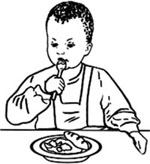11.5 Recommendations for children aged two years and older
At this age, children should be eating a variety of foods in three meals a day, as well as two snacks during the day. The table below (Table 11.4) sets out the recommendations.
| Two years and older | ||
|---|---|---|
|
| At this age the child should be taking a variety of family foods in three meals per day. The child should also be given two extra feedings between meals (snacks) per day. These may be family foods or other nutritious foods which are convenient to give between meals. |
Examples of nutritional food include kitta (flat bread of non-fermented wheat flour) and dabo (home-made bread), softened with milk. These are good sources of protein and are energy-rich complementary foods for children over two years. In addition, consumption of potatoes and fruits, such as oranges and bananas, should be encouraged.
11.4 Recommendation for children from 12 months to two years


